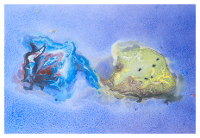Speaker
Mr
Simone Biondini
(TUM)
Description
Cosmology and particle physics come across a tight connection in the attempt
to reproduce quantitatively the results of experimental findings. Indeed, the
dark matter relic abundance and the amount of baryon asymmetry in the universe are accurately determined by the recent analysis of the cosmic microwave
background.
Majorana fermions enter in many scenarios of physics beyond the Standard
Model. In the simplest leptogenesis framework Majorana neutrinos are at the
origin of the baryon asymmetry and most of the dark matter candidates are
described by Majorana fermion fields. The non-relativistic regime comes up to
be relevant during the lepton asymmetry generation and the dark matter
dynamics at the freeze-out as well. Moreover all the interactions occur in a thermal
medium that is the universe in its early stage.
We discuss the development of an effective field theory for non-relativistic
Majorana which is analogous to the HQEFT. Then, we apply it to the case of a heavy Majorana neutrino decaying in a hot and dense plasma of Standard Model particles, whose temperature is much smaller than the mass of the Majorana neutrino but still much larger than the electroweak scale. Thermal corrections to the neutrino width are addressed.
Finally we show an effective field theory derivation of the Boltzmann equation for weakly interacting dark matter particles. The presented techniques have broad applications also to the treatment of hard probes in a hot QCD medium, for instance quarkonia suppression and jet quenching. The development and application of resummation
techniques in hot QCD or cosmology can benefit both fields.
